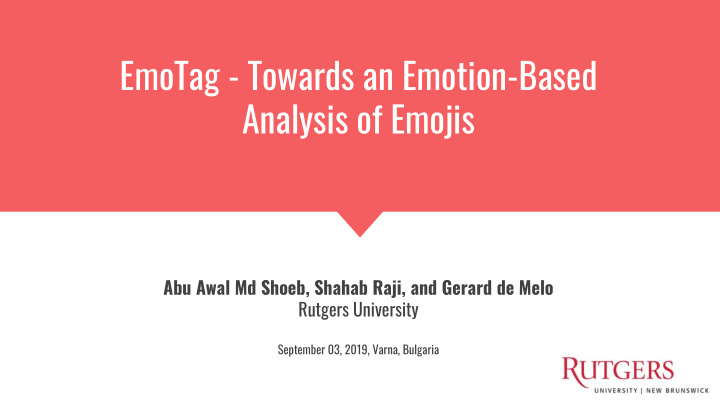



EmoTag - Towards an Emotion-Based Analysis of Emojis Abu Awal Md Shoeb, Shahab Raji, and Gerard de Melo Rutgers University September 03, 2019, Varna, Bulgaria
Emojis are Ubiquitous A study found that half of social ● media text contains emojis (as of 2015) The same parts of the brain are ● activated as when we look at a real human face Oxford Dictionaries named “Face ● With Tears of Joy” its 2015 Word of the year http://instagram-engineering.tumblr.com/post/117889701472/emojineering-part-1-machine-learning-for-emoji Emoticons in mind: An event-related potential study by Churches O, Nicholls M, Thiessen M, Kohler M, Keage H (2014) 2
Goal: Emoji-based Lexical Resources Problem: Standard word embeddings are not interpretable ● Capture relationships among words only ● No relationships between emotion and words ● What is missing: Emoji Interpretable Word Vectors based on ● emojis No lexicon for emoji-emotions yet ● Our Approach: Use emoji to derive features/emotions ● for arbitrary words Emotion Text 3
EmoTag 4
Data Acquisition & Lexicons Approach: Web Crawling Collected ~20M tweets over a period of 1 year ● 100 tweets per day for each of 620 most frequently used emoji ● Every single tweet contains at least one emoji ● Data Cleansing No more than 5 tweets from an individual user ● Each tweet contains tweet-id, text, username, date, retweets, favorites, geo-location, emoji, hashtags ● 5
Vector Induction Word2Vec on Tweets corpus word 1 word 2 ... word n emoji 1 emoji 2 emoji 3 ... emoji 620 Emoji Vectors emoji 1 emoji 2 emoji 3 emoji 620 ... word 1 Cosine_Similarity( word 2 , emoji 3 ) = 0.44 word 2 0.44 word 3 ... word n
Emoji Vector Induction 7
Evaluation of New Vectors 8
EmoInt – WASSA Shared Task Task: given a tweet and an emotion X, determine the intensity or degree of emotion X felt by the speaker Predicts the intensity of emotions in Tweets ● Intensities are real valued scores in [0,1] ● Emotions: classified as anger, fear, joy, sadness ● Approach: Supervised Learning Method Random Forest regressor with 800 trees ● Combines many features including the output of a CNN-LSTM network that ● uses our Emoji Vectors as the word embedding 9
EmoInt Results Including Other Baselines Methods Anger Fear Joy Sadness Average Dim Affective Tweets 0.65 0.66 0.60 0.69 0.65 n/a Interpretable EmoTag 0.70 0.73 0.69 0.75 0.72 620 Random Int. 0.68 0.72 0.66 0.73 0.70 300 word2vec 0.70 0.72 0.67 0.75 0.71 300 Non-Interpretable GloVe 0.70 0.73 0.68 0.76 0.72 300 GloVe Twitter 0.72 0.74 0.68 0.76 0.73 200 Pearson Correlations between Gold Score and Predicted Emotion Score for Tweets 10
Evaluating Sentiment & Emotion Scores 11
Sentiment Score Generation Evaluating Sentiment of Emojis Prediction ● NRC EmoLex is used to capture sentiment words from EmoTag ○ Find top K words (based on EmoTag Similarity Scores) for a given emoji ○ Aggregated similarity scores (K=3) are the final sentiment score ○ for that emoji Evaluation ● we use Sentiment of Emojis by Novak et al. as ground truth ○ 12
Sentiment Score Evaluation Pearson Correlations of Our Sentiment Score and Novak’s Score Comparison of Emoji Sentiment Score 13
Emotion Score Generation Evaluating Emotion of Emojis Prediction ● NRC EmoLex is used to capture emotion words from EmoTag ○ Rank top K words (based on EmoTag SImilarity Scores) for a given emoji ○ Weighted average scores (K=3) are the final emotion score for a given emoji ○ Evaluation 1 ● Affect Intensity Lexicon from NRC is used to reproduce their score using EmoTag ○ Rank top K emojis (based on EmoTag SImilarity Scores) for a given word ○ Arithmetic mean (K=10) is the final emotion scores for that word ○ Evaluation 2 ● Emoji2Emotion is used to predict Emotion Label for Emojis ○ 14
Emotion Score Evaluation 1 Snapshot of Proposed Emotion Score for Emojis Pearson Correlations of Our Score & Gold Score for Affect Intensity Lexicon 15
Emotion Score Evaluation 2 A comparison between Emoji2EMotion (E2E) and EmoTag 16
Conclusion: EmoTag It’s a huge and meaningful collection of Emoji centric Tweets ● It shows how emojis and words co-occur in social media, including their ● connection to emotions It provides a unique way to create interpretable word embedding with the help ● of emoji Thank You! Contact - abu.shoeb@rutgers.edu All resources can be found at http://emoji.nlproc.org 17
Backup 18
Co-Occurrences 19
Formation of Lexicons - An Example Tokens same 1 2 to 1 2 you 1 2 keep 1 2 smiling 1 2 happy 1 2+2 hoidaze 1 2 good 0 2 morning 0 2 thursday 0 2 20
Overview of Previously Released Dataset Paper Year Lang. Manual Annotation? # of Emoji Source/Size Class/Output Sentiment of 2015 13 EUL 83 Human Annotators 751 1.6 M Tweets - only Sentiment Emojis 4% has emoji Lexicon Emoji2Vec 2016 English No 1661 6088 Emoji Pre-trained Descriptions embeddings EmoWordNet 2018 English DepecheMood and X 67K Terms from EWN Emotion crowd-sourced Lexicon Emoji2Emotion 2018 English 500 Human annotated 31+50 84777 tweets Emoji Emotion tweets Mapping Tech. EmoLex 2010 English 1012 X 200 n-grams and Emotion bi-grams in 4 Lexicon categories There are no such huge dataset consists of frequently used emoji and text 21
Recommend
More recommend